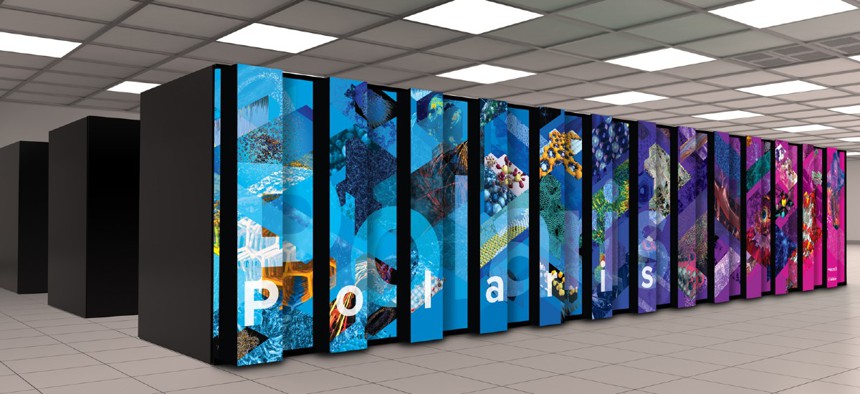Argonne National Lab Inches Closer to Exascale Age with New ‘Testbed’ Supercomputer

An artist's rendering of the Polaris supercomputer. Courtesy Nvidia
Polaris will support the Energy Department’s user community as it prepares for new, more powerful computing capabilities.
The Energy Department’s Argonne National Laboratory is getting set to deploy a new high performance, testbed supercomputer that the research community will use to prepare next-level workloads for the forthcoming exascale era of computing.
Named Polaris by the Illinois-based lab’s officials, the machine will be built by Hewlett Packard Enterprise with components from Nvidia and other companies. It’ll be based at the Argonne Leadership Computing Facility, or ALCF. Polaris comes as that user-supporting hub is poised to gain Aurora, one of the three exascale systems slated for Energy. In this next age of supercomputing performance, units will perform in exaflops and essentially be multiple orders of magnitude more powerful than today’s fastest.
HPE is also involved in Aurora’s buildout. The system was first mentioned in 2019, and originally slated to be America’s first in-operation exascale machine. After reported delays, it is now set to arrive at Argonne next year.
Researchers and others involved in DOE’s Exascale Computing Project will use Polaris for optimizing engineering tasks and other projects to ultimately ready for Aurora. This new machine, announced Wednesday, will go into operation starting early 2022 and Energy will open it up to the broader community for use in the spring.
ALCF Director of Technology Kalyan Kumaran told Nextgov on Tuesday that the two supercomputers share similarities, including that they both support multi-graphics processing unit nodes connected by the HPE Slingshot network, and programming models that are of interest to the lab.
“This makes it possible to develop on one platform and transition to the other,” Kumaran explained.
Polaris is expected to deliver roughly 44 petaflops of peak double precision performance—as well as nearly 1.4 exaflops of theoretical artificial intelligence performance. Those operational levels are based on an array of components. The system will run on Nvidia’s accelerated computing platform. It will lean on simulation and machine learning and be used to pursue data-intensive and AI-enabled computing workloads, enhancing the department's core applications being developed for Aurora.
“This is going to allow their developers, application owners and their engineers to start building out capabilities for accelerated computing at a grand scale,” Dion Harris, Nvidia's lead product marketing manager for accelerated computing, told reporters on Monday.
He noted that the power behind Polaris has potential to place it among the most powerful supercomputers on Earth. Highlighting potential exascale uses down the line, Harris said simulations will be unleashed to help understand problems around neuroscience, how the brain functions, and how to help solve diseases like Alzheimer's or dementia.
When it’s first put to use, Polaris will be specifically dedicated to research teams affiliated with existing initiatives, like the DOE’s Exascale Computing Project and the ALCF’s Aurora Early Science Program. People involved in those are already using advanced supercomputing techniques to drive forward cancer research and treatments, and experiments to improve the nation’s energy security. Beyond that, the new supercomputer will also enable officials to integrate high performance computing and AI with other experimental facilities, including Argonne’s Advanced Photon Source and the Center for Nanoscale Materials.
“ALCF will continue to support Polaris after Aurora is here and the flexible architecture might allow exploration of other accelerators and workloads,” Argonne’s Kumaran said.






